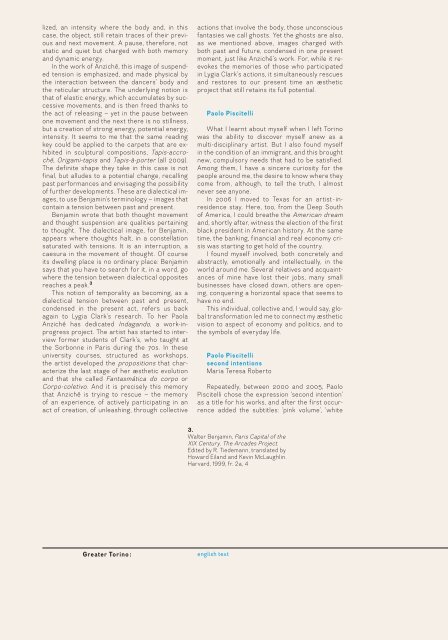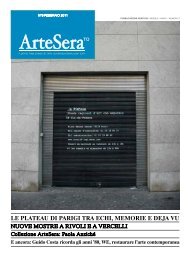Download Catalogue - Paola Anziché
Download Catalogue - Paola Anziché
Download Catalogue - Paola Anziché
Create successful ePaper yourself
Turn your PDF publications into a flip-book with our unique Google optimized e-Paper software.
lized, an intensity where the body and, in this<br />
case, the object, still retain traces of their previous<br />
and next movement. A pause, therefore, not<br />
static and quiet but charged with both memory<br />
and dynamic energy.<br />
In the work of <strong>Anziché</strong>, this image of suspended<br />
tension is emphasized, and made physical by<br />
the interaction between the dancers’ body and<br />
the reticular structure. The underlying notion is<br />
that of elastic energy, which accumulates by successive<br />
movements, and is then freed thanks to<br />
the act of releasing – yet in the pause between<br />
one movement and the next there is no stillness,<br />
but a creation of strong energy, potential energy,<br />
intensity. It seems to me that the same reading<br />
key could be applied to the carpets that are exhibited<br />
in sculptural compositions, Tapis-accroché,<br />
Origami-tapis and Tapis-à-porter (all 2009).<br />
The definite shape they take in this case is not<br />
final, but alludes to a potential change, recalling<br />
past performances and envisaging the possibility<br />
of further developments. These are dialectical images,<br />
to use Benjamin’s terminology – images that<br />
contain a tension between past and present.<br />
Benjamin wrote that both thought movement<br />
and thought suspension are qualities pertaining<br />
to thought. The dialectical image, for Benjamin,<br />
appears where thoughts halt, in a constellation<br />
saturated with tensions. It is an interruption, a<br />
caesura in the movement of thought. Of course<br />
its dwelling place is no ordinary place: Benjamin<br />
says that you have to search for it, in a word, go<br />
where the tension between dialectical opposites<br />
reaches a peak. 3<br />
This notion of temporality as becoming, as a<br />
dialectical tension between past and present,<br />
condensed in the present act, refers us back<br />
again to Lygia Clark’s research. To her <strong>Paola</strong><br />
<strong>Anziché</strong> has dedicated Indagando, a work-inprogress<br />
project. The artist has started to interview<br />
former students of Clark’s, who taught at<br />
the Sorbonne in Paris during the 70s. In these<br />
university courses, structured as workshops,<br />
the artist developed the propositions that characterize<br />
the last stage of her æsthetic evolution<br />
and that she called Fantasmática do corpo or<br />
Corpo-coletivo. And it is precisely this memory<br />
that <strong>Anziché</strong> is trying to rescue – the memory<br />
of an experience, of actively participating in an<br />
act of creation, of unleashing, through collective<br />
Greater Torino :<br />
actions that involve the body, those unconscious<br />
fantasies we call ghosts. Yet the ghosts are also,<br />
as we mentioned above, images charged with<br />
both past and future, condensed in one present<br />
moment, just like <strong>Anziché</strong>’s work. For, while it reevokes<br />
the memories of those who participated<br />
in Lygia Clark’s actions, it simultaneously rescues<br />
and restores to our present time an æsthetic<br />
project that still retains its full potential.<br />
Paolo Piscitelli<br />
What I learnt about myself when I left Torino<br />
was the ability to discover myself anew as a<br />
multi-disciplinary artist. But I also found myself<br />
in the condition of an immigrant, and this brought<br />
new, compulsory needs that had to be satisfied.<br />
Among them, I have a sincere curiosity for the<br />
people around me, the desire to know where they<br />
come from, although, to tell the truth, I almost<br />
never see anyone.<br />
In 2006 I moved to Texas for an artist - inresidence<br />
stay. Here, too, from the Deep South<br />
of America, I could breathe the American dream<br />
and, shortly after, witness the election of the first<br />
black president in American history. At the same<br />
time, the banking, financial and real economy crisis<br />
was starting to get hold of the country.<br />
I found myself involved, both concretely and<br />
abstractly, emotionally and intellectually, in the<br />
world around me. Several relatives and acquaintances<br />
of mine have lost their jobs, many small<br />
businesses have closed down, others are opening,<br />
conquering a horizontal space that seems to<br />
have no end.<br />
This individual, collective and, I would say, global<br />
transformation led me to connect my æsthetic<br />
vision to aspect of economy and politics, and to<br />
the symbols of everyday life.<br />
Paolo Piscitelli<br />
second intentions<br />
Maria Teresa Roberto<br />
Repeatedly, between 2000 and 2005, Paolo<br />
Piscitelli chose the expression ‘second intention’<br />
as a title for his works, and after the first occurrence<br />
added the subtitles: ‘pink volume’, ‘white<br />
3.<br />
Walter Benjamin, Paris Capital of the<br />
XIX Century. The Arcades Project.<br />
Edited by R. Tiedemann, translated by<br />
Howard Eiland and Kevin McLaughlin.<br />
Harvard, 1999, fr. 2a, 4<br />
english text



